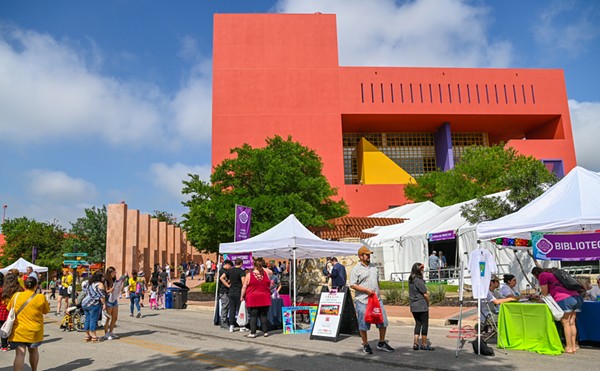In honor of Giacomo Puccini’s 150th birthday, the San Antonio Opera opens its 2007-08 season with La Bohème, the Italian composer’s classic tale of art, love, and loss among the bohemian inhabitants of Paris’s famed Latin Quarter in the 1830s. Completed in 1896, La Bohème is one of the few opera mainstays that no self-respecting company (or aspiring opera buff) should skip. It’s possibly the most-performed of all operas and certainly one of the most popular.
The plot:
Four friends — Rodolfo the poet, Marcello the painter, Colline the philosopher, and Schaunard the musician — share a room in the Latin Quarter. Marcello is in love with the feisty, promiscuous Musetta, but they’ve parted ways. Rodolfo falls in love with Mimi, a fragile, sweet beauty with a cough. Marcello is reunited with Musetta, but it’s volatile. Rodolfo’s fits of jealousy are the superficial cause of a break-up with Mimi, but really it’s his awareness that she’s ill and he has no means of taking care of her. They part plaintively, still very much in love. In the final act, Marcello and Rodolfo inform each other that each has seen the other’s girl, dressed in finery from wealthy lovers. As the four roommates engage in a merry mock feast, they are interrupted by a frantic Musetta, who has discovered Mimi. She’s left her benefactor and is dying. She is reunited with Rodolfo, they declare their love, and she dies.
Based on:
Scènes de la vie de Bohème, a popular novel by Henry Murger, first published as a serial in 1844. It’s a collection of vignettes from the poverty-stricken yet free-wheeling bohemian haunts of the 1830s and ’40s. The characters and events are based on Murger’s own experiences, including our heroine Mimi’s death — she’s an amalgam of several young girls who died of privation and consumption (tuberculosis) in Murger’s circle.
World performances:
La Bohème always tops the list of most-produced operas, and this season is particularly ripe. Santa Fe Opera featured it this summer, and both the New York City Opera and the Metropolitan have it scheduled. Can’t make the trip? Subscribers to Sirius Satellite Radio can tune in to a live broadcast from the Met on April 5. Better yet, watch for the listing of local theater venues for the April 26 High Definition Simulcast. Going to Tokyo in the fall? Catch La Bohème at the New National Theatre, or the West Australian Opera in Perth. European and American productions are too numerous to count: Chicago, Boston, Miami, even Opera of the Ozarks have La Bohème on the program. If you’re traveling to a city with an opera company, odds will be in La Bohème’s favor.
The libretto:
La Bohème’s foundation is a well-crafted libretto by Giuseppe Giacosa and Luigi Illica, who also developed the scripts for Puccini’s Tosca (1900) and Madama Butterfly (1904). The complex dialogue and character development are concise and focused, yet florid enough to convey the tenderness and volatility of the love affairs and the philosophical intensity of the main characters. Their banter is at turns funny, biting, insightful, irreverent, and absolutely believable, reinforcing the friendship and intellectual engagement of the characters and driving the action to its inevitable end.
The music:
Puccini is always a master of orchestration, but in La Bohème he was in top form. The music defines characters and emotional tone. The arias are concise without sacrificing melodic, lyrical, or expressive nuance. Dialogue is clear and emotive. The music serves the drama, but it’s actually the real reason to go to a live opera. Ultimately, it’s the quality of the performance that makes it all work.
S.A. Opera:
La Bohème may be the most-produced opera, but it’s still a big undertaking. Sets for the SA performance come from the New Orleans Opera; Artistic Director Mark Richter says it’s the largest they’ve dealt with. The elaborate staging includes adult chorus, children’s chorus, a marching band, 130 costumes, and a full gamut of emotion from comedy to tragedy.
Supertitles will be a direct translation into common English. The top-notch cast was chosen from national auditions. Conductor Enrique Patron de Rueda, Head of the Orchestra at Teatro de Bellas Artes and Artistic Director of the National Opera Company in Mexico City, brings his dynamic musical rendering to the 42-member orchestra.
Richter’s biggest challenge? “Convincing an audience coming from 100-degree heat that it’s Christmas Eve in Paris and the actors are freezing.” •
La Bohème runs August 24 – 26. Single or season tickets are still available, call (210) 225-5972 or see Saopera.com. Season continues in 2008 with Donizetti’s Elixir of Love January 25-27, and closes with another Puccini masterpiece, Tosca, June 27-29. All performances in Italian with English supertitles at Lila Cockrell Theater.

















